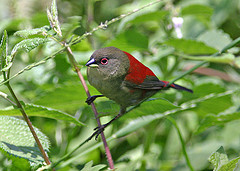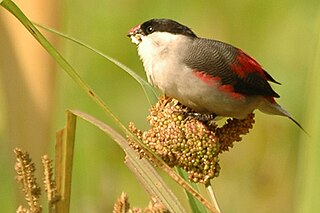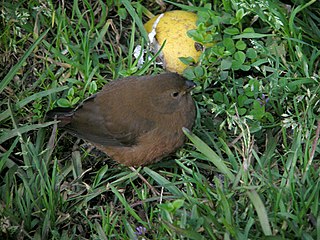 W
WEstrildidae, or estrildid finches, is a family of small passerine birds of the Old World tropics and Australasia. They comprise species commonly known as munias, mannikins, firefinches, parrotfinches and waxbills. Sometimes they are treated as a subfamily, Estrildinae, within the family Passeridae; Passeridae narrowly defined comprises the Old World sparrows. Despite the word "finch" being included in the common names of many of the species, they are not closely related to birds with this name in other families, such as the Fringillidae, Emberizidae or Passerellidae.
 W
WEstrildidae, or estrildid finches, is a family of small passerine birds of the Old World tropics and Australasia. They comprise species commonly known as munias, mannikins, firefinches, parrotfinches and waxbills. Sometimes they are treated as a subfamily, Estrildinae, within the family Passeridae; Passeridae narrowly defined comprises the Old World sparrows. Despite the word "finch" being included in the common names of many of the species, they are not closely related to birds with this name in other families, such as the Fringillidae, Emberizidae or Passerellidae.
 W
WAmadina is a genus of estrildid finches. Established by William John Swainson in 1827, it contains the following species:
 W
WAmandava is a genus of the estrildid finches. These birds are found in dense grass or scrub in Africa and South Asia. They are gregarious seed-eaters with short, red bills. In earlier literature, amadavat and amidavad have been used. The name amandava, along with amadavat and amidavad are all corruptions of Ahmedabad, a city in Gujarat, India from where the first few specimens of the red munia Amandava amandava were obtained.
 W
WThe bluebills are the genus Spermophaga of the estrildid finches family. These birds are found in tropical Africa. They are gregarious seed eaters with short, thick, blue and red bills. All have plumage which is mainly crimson and black or dark grey.
 W
WThe brown twinspot is a common species of estrildid finch found in sub-Saharan Africa. It is the only member of the genus Clytospiza.
 W
WCoccopygia, is a genus of songbirds that range across Sub-Saharan central and southern Africa.
 W
WThe crimsonwings (Cryptospiza) are a genus of small passerine birds belonging to the estrildid finch family (Estrildidae). There are four species. They are found in parts of Sub-Saharan Africa, particularly the Albertine Rift; all four species occur there and two, Shelley's and dusky crimsonwings, are found nowhere else. They are secretive birds which mainly inhabit mountain forests with dense undergrowth. They usually forage on or near the ground, feeding mainly on seeds such as those of grasses and balsam.
 W
WThe double-barred finch is an estrildid finch found in dry savannah, tropical (lowland) dry grassland and shrubland habitats in northern and eastern Australia. It is sometimes referred to as Bicheno's finch or as the owl finch, the latter of which owing to the dark ring of feathers around the face.
 W
WParrotfinches are small, colourful passerine birds belonging to the genus Erythrura in the family Estrildidae, the estrildid finches. They occur from South-east Asia to New Guinea, and many Pacific Islands. They inhabit forest, bamboo thickets and grassland and some can be found in man-made habitats such as farmland, parks and gardens. Several species are commonly kept as cagebirds.
 W
WEstrilda is a genus of estrildid finch in the family Estrildidae.
 W
WEuodice is a genus of estrildid songbirds that is recognized by some authorities while some include it within the genus Lonchura where it is treated as a subgenus. Its members are from the dry zones of Africa and India and are commonly referred to as silverbills. The African and Indian species were earlier considered conspecific because they can interbreed. They are phylogenetically distinct and form a clade that is basal to other relatives in Estrildidae.
 W
WThe crimson finch is a species of bird in the family Estrildidae. It is found throughout Northern Australia as well as parts of southern New Guinea. Crimson finches feature a distinctively bright crimson coat and are known for their aggression.
 W
WThe Gouldian finch, also known as the Lady Gouldian finch, Gould's finch or the rainbow finch, is a colourful passerine bird that is native to Australia.
 W
WThe green-backed twinspot or green twinspot is an estrildid finch found in many parts of Sub-Saharan Africa. The IUCN has classified the species as being of least concern.
 W
WThe grey-headed oliveback, also known as the white-cheeked oliveback, is a common species of estrildid finch found in Africa. It has an estimated global extent of occurrence of 800,000 km².
 W
WThe locust finch or locustfinch is a species of estrildid finch found in south-central and south-eastern Africa. It is the only species in the genus Paludipasser. It is sometimes placed in the genus Ortygospiza.
 W
WThe Madagascan mannikin is a common species of estrildid finch native to Madagascar. It has an estimated global extent of occurrence of 100,000 to 1,000,000 km2. Other names for this species include Madagascar munia, bibfinch, African bibfinch, African parsonfinch, and dwarf mannikin.
 W
WThe mountain firetail is a common species of estrildid finch found in New Guinea. It has an estimated global extent of occurrence of 20,000-50,000 km2. It is the only species in the genus Oreostruthus.
 W
WNesocharis is a genus of bird in the family Estrildidae. Established by Boyd Alexander in 1903, it contains the following species:
 W
WThe grey-headed silverbill, also known as pearl-headed mannikin, is a species of estrildid finch found in eastern Africa, Ethiopia, Kenya, South Sudan, and Tanzania. It has an estimated global extent of occurrence of 400,000 km². It is now usually placed in the monotypic genus Odontospiza as Odontospiza caniceps. It is sometimes placed in the genus Lonchura.
 W
WThe painted finch is a common species of estrildid finch found in Australia. The painted finch acquired its name due to the red and white spotted and mottled underparts of both males and females. The Latin name comes from emblema meaning mosaic or inlaid work; and pictum was derived from the Latin work pictus, meaning painted. Other names include Emblema finch, Mountain finch, Painted firetail and Emblema. The painted finch is a popular bird to be kept in captivity and in backyard aviaries.
 W
WThe pictorella mannikin, pictorella munia, or pictorella finch is small brown and grey finch with a grey bill and distinctive scaly white breast plate which is endemic to northern Australia. It is a seed-eater found in pairs and small flocks in dry savannah and subtropical or tropical dry lowland grassland.
 W
WThe plum-headed finch also known as cherry finch is a common species of estrildid finch found in Australia. It has an estimated global extent of occurrence of 100,000 – 1,000,000 km2.
 W
WPoephila is an Australian genus of estrildid finches.
 W
WThe seedcrackers are the genus Pyrenestes of the estrildid finches family. These birds are found in Sub-Saharan Africa. They are gregarious seed eaters with short, very thick, grey bills. All have crimson on the face and tail.
 W
WThe bluebills are the genus Spermophaga of the estrildid finches family. These birds are found in tropical Africa. They are gregarious seed eaters with short, thick, blue and red bills. All have plumage which is mainly crimson and black or dark grey.
 W
WStagonopleura is an Australian genus of the family Estrildidae. It is sometimes absorbed into Emblema.
 W
WThe star finch is a seed-eating bird species found in northern Australia. It has a distinctive red face and bill, and broad white spots down its flanks. One of its three subspecies may be extinct.
 W
WUraeginthus is a genus of birds in the family Estrildidae.
 W
WEstrildidae, or estrildid finches, is a family of small passerine birds of the Old World tropics and Australasia. They comprise species commonly known as munias, mannikins, firefinches, parrotfinches and waxbills. Sometimes they are treated as a subfamily, Estrildinae, within the family Passeridae; Passeridae narrowly defined comprises the Old World sparrows. Despite the word "finch" being included in the common names of many of the species, they are not closely related to birds with this name in other families, such as the Fringillidae, Emberizidae or Passerellidae.